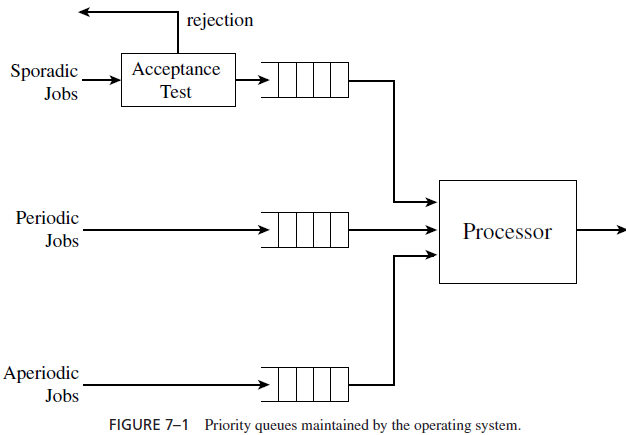SKEDSOFT
Objectives, Correctness, and Optimality: Throughout this chapter, we assume that we are given the parameters {pi } and {ei } of all the periodic tasks and a priority-driven algorithm used to schedule them. Moreover, when the periodic tasks are scheduled according to the given algorithm and there are no aperiodic and sporadic jobs, the periodic tasks meet all their deadlines. For the sake of concreteness, we assume that the operating system maintains the priority queues shown in Figure 7–1. The ready periodic jobs are placed in the periodic task queue, ordered by their priorities that are assigned according to the given periodic task scheduling algorithm. Similarly, each accepted sporadic job is assigned a priority and is placed in a priority queue, which may or may not be the same as the periodic task queue. Each newly arrived aperiodic job is placed in the aperiodic job queue. Moreover, aperiodic jobs are inserted in the aperiodic job queue and newly arrived sporadic jobs are inserted into a waiting queue to await acceptance without the intervention of the scheduler.
The algorithms described in this chapter determine when aperiodic or sporadic jobs are executed. We call them aperiodic job and sporadic job scheduling algorithms; they are solutions to the following problems:
1. Based on the execution time and deadline of each newly arrived sporadic job, the scheduler decides whether to accept or reject the job. If it accepts the job, it schedules the job so that the job completes in time without causing periodic tasks and previously accepted sporadic jobs to miss their deadlines. The problems are how to do the acceptance test and how to schedule the accepted sporadic jobs.
2. The scheduler tries to complete each aperiodic job as soon as possible. The problem is how to do so without causing periodic tasks and accepted sporadic jobs to miss their deadlines.

Hereafter, by algorithm, we mean specifically an aperiodic job or sporadic job scheduling algorithm, except when it is stated otherwise. Such an algorithm is correct if it produces only correct schedules of the system. By a correct schedule, we mean one according to which periodic and accepted sporadic jobs never miss their deadlines.We consider only correct algorithms. In our subsequent discussion, we will omit the reminder that the actions of the scheduler according to the algorithm being described must never cause any periodic or sporadic job in the system to be late.
Finally, we assume that the queueing discipline used to order aperiodic jobs among themselves is given. An aperiodic job scheduling algorithm is optimal if it minimizes either the response time of the aperiodic job at the head of the aperiodic job queue or the average response time of all the aperiodic jobs for the given queueing discipline. An algorithm for (accepting and) scheduling sporadic jobs is optimal if it accepts each sporadic job newly offered to the system and schedules the job to complete in time if and only if the new job can be correctly scheduled to complete in time by some means.